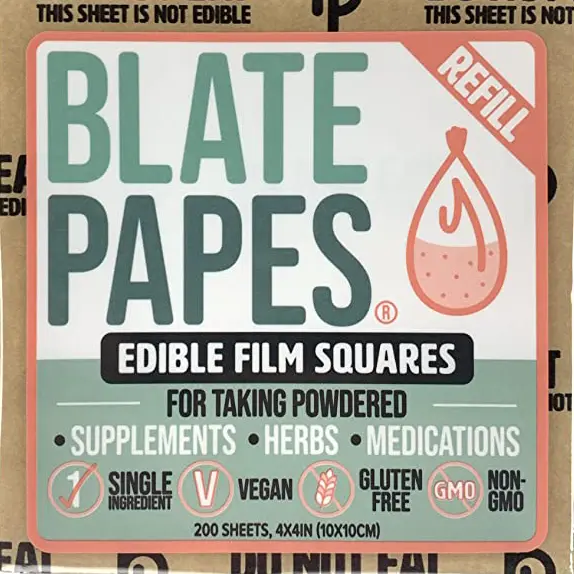Oblate Discs
It might sound like something related to human anatomy. But they are nothing more than gelatinized starch pouches! These starch discs are known as Japanese edible films owing to their origin. Parachuting kratom is one way that kratom is utilized with oblate discs.
The oblate discs/pouches are used in various ways- from candy making to making bitter herbs more palatable. Nowadays, these are more commonly used for consuming Kratom. Blate Papes is one of the more well known brands of oblate discs on the market. Blate Papes are easy to use and can be found online.
Kratom has very bitter alkaloids. And even so, there are pills on the market, and the oblate discs perform better! They have a barrier effect like a pill but allow for more powder consumption!
Let’s discuss these fascinating discs some more!
Origin of Oblate Discs
The Dutch were the pioneers in the use of Oblate discs, which were initially simple hardened clumps of bread or rice. However, as time progressed, the concept of Oblate discs underwent significant changes. It was during the 1800s, a period marked by Dutch-Japanese trade relations, that the Dutch shared their knowledge of Oblates with the Japanese.
The early Oblate discs were essentially compacted masses of bread or rice, which served various purposes. These discs were primarily used as a convenient and portable form of sustenance, especially during long journeys or in situations where fresh food was scarce. The hardened nature of the discs allowed them to be easily stored and transported without the risk of spoilage.
As the Dutch and Japanese engaged in trade, the Dutch recognized the value and practicality of Oblate discs and decided to share their knowledge with the Japanese. This exchange of information led to the refinement and improvement of Oblate discs. The Japanese, known for their meticulous craftsmanship and attention to detail, began experimenting with different ingredients and techniques to enhance the quality and versatility of the discs.
Over time, the composition of Oblate discs evolved beyond simple bread or rice clumps. The Japanese introduced various flavors, such as herbs and spices, to enhance the taste and appeal of the discs. They also experimented with different types of grains and flours, resulting in a wider range of options for consumers.
The improved Oblate discs gained popularity not only in Japan but also in other parts of the world. Their compact size, long shelf life, and versatility made them a favored choice for travelers, soldiers, and individuals in need of a convenient and nutritious food source. Oblate discs became an essential part of military rations, emergency supplies, and even everyday meals for many people.
Today, Oblate discs continue to be used and appreciated in various cultures and contexts. They have become a symbol of ingenuity and resourcefulness, representing the ability to transform simple ingredients into a practical and versatile food product. The Dutch’s initial discovery and subsequent sharing of Oblate knowledge with the Japanese played a crucial role in the development and widespread adoption of these unique food items.
Interestingly, the modern variations of these popular discs now come from a doctor in Mie Prefecture, Japan, Masataro Kobayashi, who, in 1902, made these discs from starch and agar. What’s fascinating is that he discovered these by complete accident! However, his version of the discs became the commercialized version used today.
Making of Oblate Discs
To make oblate discs, a mix of starch and water is shaped into circles and dried on racks. As mentioned before, this starch-water combination is known as Japanese edible film, which is entirely safe for consumption. Vegetable starch, especially from potatoes and rice, is used and usually has no taste.
For-profit and to make a name in the market, most companies add specific other components to their mixtures to obtain better discs. But doing so might cause the starch to take longer to break down.
- It can prolong the time it takes for the herb to take effect!
- The best oblate discs are the ones that are prepared only from starch and laid super thin!
- The thinner they are, the easier they’ll break open after consumption.
Typically, candy manufacturers should use thicker discs (about 40µm) when using them. The ones used for wrapping pharmaceutical powders and drugs are typically around 10-20µm thick.
Although Kratom pills and capsules have been widely taken from their usage because of better transportation and storage, oblates remain undefeated. Because when it comes to filling and swallowing large amounts of powder, oblates are the best choice!
How to Use Oblate Discs to Take Kratom?
The most crucial step before one can start taking Kratom is to ensure that the Kratom is of good quality. A credible store is a great start. Once you have your Kratom, the second step is to measure a proper dose.
Remember! The dosage for taking Kratom is essential.
Now that you have your Kratom ready, the next steps are as follows:
- Lay out an oblate disc on a flat surface.
- Spoon or measure out the proper dose of Kratom onto the disc. Ensure that the powder is scattered within the center and doesn’t overfill to the point of spilling.
- Once the powder is placed, fold over the edges of the disc onto itself. This process can be repeated till the disc encloses the powder completely.
- A small quantity of water can be applied to the edges as a sealant to prevent the powder from spilling.
- Once you have your oblate pouch full of powder, you can use a spoon or your hand for consumption.
Kratom users, at times, drop the entire pouch into the water to ensure that it encloses the powder properly. Dropping the disc into the water can become an issue as Kratom is readily absorbed right after consumption.
A user can fold the oblate disc in several ways, but some of the more commonly preferred methods include the following:
- Burrito Fold: This involves folding the disc’s edges inwards from either side.
- Teardrop Fold: consists in folding the disc into a teardrop shape, i.e., a sac-like shape.
Oblate Disc Vs. Toss and Wash
The Toss and Wash method is a tried-and-true method that is most popular with Kratom users. It enables a person to consume large amounts of Kratom powder with ease. It is also instantaneous in action. The Toss and Wash method is also convenient as it requires no preparation for consumption.
On the other hand, oblate discs help mask the bitter alkaloidal taste of Kratom, allowing for easier swallowing. The dose is also more controlled than in a Toss and Wash, which most people see as a drawback. The primary thing to think about in the Oblate Disc method is buying the discs for the store and preparing your Kratom onto them. The discs can also accumulate moisture and break down, so storage can become an issue.
Is It a Safe Approach?
The Oblate discs have wildly succeeded within the Kratom community and have easily replaced traditional consumption methods. Pills and Powders usually have their ways of use which people still prefer. Most people still prefer to Toss and Wash their Kratom, while others find swallowing pills much more accessible. Everyone has their preference.
For a beginner at Oblate Discs, starting with a low dose of Kratom on their disc is highly recommended. The low amount is to ensure that they get used to the feeling and method of it.
It is also suggested that a user should take an oblate disc should be taken on a full or partially full stomach. But to answer the question. Yes, it is safe to use oblate discs for Kratom.
Conclusion
These Japanese discs of goodness have taken the world of Kratom by storm. And rightfully so! From a long-standing history of being used in candy to pharmaceuticals, the oblate disc is an invention worthy of a try.
They serve as a perfect middle ground between the Toss and Wash method and Kratom Pills. They are easy to consume and more palatable.
The best way to judge these discs would be to try them yourselves. Although, there is the issue of finding kratom vendors that sell the discs. The prices are usually affordable. Affordability makes it more worthwhile to try it out!






0 Comments